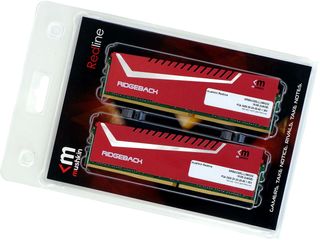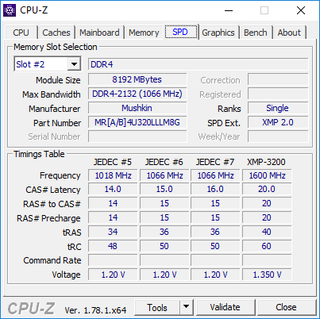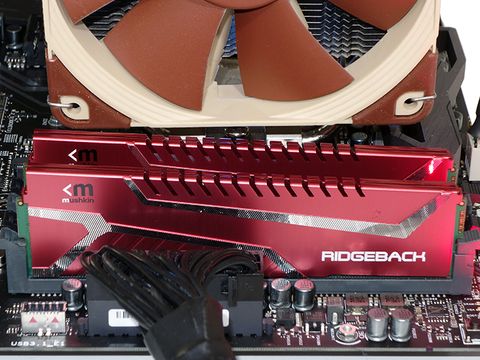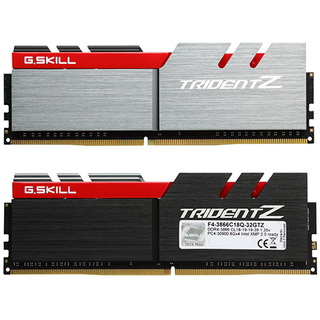Early Verdict
With comparatively high latency and little overclocking capability, Mushkin’s Redline Ridgeback MRB4U320LLLM8GX2 will likely appeal to DDR4-3200 buyers who care mostly about ease of installation.
Pros
- +
Red-anodized heat spreaders with flat tops that don’t dig into thumbs during installation
- +
Limited lifetime warranty
- +
Mushkin’s US-based tech support
Cons
- -
Expensive
- -
High latency
- -
Limited overclocking capability
Why you can trust Tom's Hardware
Introducing Redline Ridgeback DDR4-3200
What started as a memory series with high-priced heat spreaders to help overclockers expel heat, the lower voltage of DDR4 has allowed Mushkin to scale back its Ridgeback design to become little more than an aesthetic treatment. You still get Mushkin’s top rated Redline modules under the skin, it’s just that the skin need not be as elaborate when covering today’s lower voltage ICs.

I like to start off with names that people can remember, and Redline Ridgeback DDR4-3200 is easily remembered. Conversely, the model number MRB4U320LLLM8GX2 isn’t. Because this is the only currently available 16GB dual-channel kit of Ridgeback DDR4-3200, you probably won’t need to remember that model number.

Ridgeback DDR4-3200 comes with highly conservative CAS 20 timings, bucking the enthusiast trendline of 1 cycle latency for every 200 MHz of data rate that has brought us DDR4-3200 CAS 16, DDR3-1600 CAS 8, DDR2-800 CAS 4, and DDR-400 CAS 2. Benchmarks will determine how this impacts performance, and we'll also drive the modules through traditional overclocking and latency optimization routines to find out how much performance has been left in reserve.

Regardless of what some readers keep saying, CPU-Z remains a relatively useful program for displaying a module’s top four timing sets in an easy screen shot format when deployed on most motherboards. It accurately shows DDR4-3200 (1600 MHz clock) timings available using a motherboard’s XMP setting, along with the DDR4-2133 (1066 MHz clock) CAS 15 timings that most motherboards will use when XMP mode is disabled.

Standing up to 1.65” (42mm) tall and rated at 1.35V, Mushkin’s Redline Ridgeback DDR4-3200 16GB dual-channel kit carries a (limited) lifetime replacement warranty. As with most manufacturers, its liability exclusions mean that if a single-bit failure causes your nuclear reactor to melt down, the company will replace the defective module (assuming you can still get to it) but won’t pay to replace the reactor. That is, unless it’s a Mushkin Reactor.
Test Setup
Recent improvements in motherboard firmware and circuit layout that are designed to complement the latest CPU memory controller revisions have finally produced a test system capable of exceeding DDR4-4000 when using top modules, without significantly exceeding the 1.35V DIMM limit suggested by Intel. A newer graphics card and storage complete our latest upgrade.
Supplied for use in motherboard reviews, G.Skill’s 32GB four DIMM DDR4-3866 kit is the starting point for today’s review. Teamgroup’s DDR4-3600 fills the data rate gap between Mushkin’s DDR4-3200 and G.Skill’s DDR4-3866.
MORE: Best Memory
MORE: DDR DRAM FAQs And Troubleshooting Guide
MORE: All Memory Content
-
InvalidError It would be nice to see timing and clock results on Ryzen's quirky memory controller. With Ryzen's fabric bandwidth and latency tied to the memory clock, performance scaling with memory should also be more interesting.Reply
I'm guessing something like that is already in the works but there is no rush to get it done while board manufacturers are still releasing BIOS updates every week to tweak things. -
hannibal Yep. Ryzen test requires quite some bios upgrades, so that more different memories gets supported. It is still very young platform.Reply -
max0x7ba Other memory reviews use different methodology and their results are more dramatic: http://www.techspot.com/article/1171-ddr4-4000-mhz-performance/Reply -
Crashman Reply
Obviously, if you add enough graphics power you can find your bottleneck elsewhere in applications that lean heavily on the GPU (games, some encoders, etc). And if you put in a fast enough processor, the lightly threaded processor-heavy apps will again be limited by something else, likely the RAM. And then, if you use a heavily threaded processor-heavy app, good luck finding a processor with enough cores and overclocking capability to make the RAM appear the bottleneck...but it's still possible.19470510 said:Other memory reviews use different methodology and their results are more dramatic: http://www.techspot.com/article/1171-ddr4-4000-mhz-performance/
I try to present a graphics and CPU performance level that people without that kind of money and tenacity could realistically expect to use, and not limit my application selection to best case scenarios. But thanks for pointing out the Handbrake and Adobe benchmarks, I might add those at a future date :D
-
JackNaylorPE Crash:Reply
Very mush welcome the comments about bottlenecking. This is my biggest beef with memory reviews as blanket conclusions are drawn that "faster RAM has no impact" when a) they never look at minimum frame rates b) they only use a small subset of games usually ignoring ones that are impacted by memory performance (STALKER, F1, etc) and c) use a test bed where the system is bottle necked by something else. The reviews I am looking for would include:
a) Typical gaming enthusiast system w/ 1080 Ti
b) Typical gaming enthusiast system w/ 1080 Ti in SLI
c) Typical moderate system w/ 1060
d) Typical moderate system w/ 480
e) Wide spectrum of games including ones generally viewed as GFX bound, CPU bound and memory bound
If the article is extended to the realm of workstation performance, then of course Adobe premiere, AutoCADm handbrake would be welcome additions and, to cover all bases both an i7 and a workstation class CPU say 6850k
As for the product being reviewed, well this is certainly disappointing ... Always look to Mushkin 1st when looking for RAM but that won't continue w/o options better than CAS 20 .. and at more attractive pricing. A $170 product in a price / performance niche that delivers faster products (CAS 16) for $50 less I don't need to hear about, and if I do, I think the critical fact to be delivered is that the product, at present, is greatly overpriced and that you could do better for $50 less.
As to the approach, while I don't want to be critical, I gotta say that ... for me ... I wish a different approach has been taken. With 3200 being the point above which the price / performance curve heads sharply towards the sky, the reader I think would have been better served comparing it with other options in the same speed range. At 3200, CAS 16 starts at about $120 .... At 3600, it's $150 more ... and at 3866, we're talking $230 (All pricing per pcparttpicker, this date).
So I don' see the value in comparing product categories where the going rate is twice that of the other, even if the subject of the review is vastly overpriced. After noting that 4 sticks have an inherent advantage on this platform, I don't quite why the article doubled down on the the "apples and oranges" means of comparison.
I think it also shuda been noted that the price was rather extreme for a 16GB set @ 3200. I expect to pay more for Mushkin, I expect to pay more for better timings .... but this set is certainly not worthy of the Redline designation ... shuda been a blackline and at a lower price. -
Crashman Reply
First of all, when we were using the old system with the GTX 970, the only way to get past the GPU bottleneck in games was to set a lower setting. We saw gains from 170 to 190 FPS or more at the lower setting, but those settings were irrelevant to real-world game play. So, it really took the GTX 1080 to get us at a point where the difference mattered.19474731 said:Crash:
Very mush welcome the comments about bottlenecking. This is my biggest beef with memory reviews as blanket conclusions are drawn that "faster RAM has no impact" when a) they never look at minimum frame rates b) they only use a small subset of games usually ignoring ones that are impacted by memory performance (STALKER, F1, etc) and c) use a test bed where the system is bottle necked by something else. The reviews I am looking for would include:
a) Typical gaming enthusiast system w/ 1080 Ti
b) Typical gaming enthusiast system w/ 1080 Ti in SLI
c) Typical moderate system w/ 1060
d) Typical moderate system w/ 480
e) Wide spectrum of games including ones generally viewed as GFX bound, CPU bound and memory bound
If the article is extended to the realm of workstation performance, then of course Adobe premiere, AutoCADm handbrake would be welcome additions and, to cover all bases both an i7 and a workstation class CPU say 6850k
As for the product being reviewed, well this is certainly disappointing ... Always look to Mushkin 1st when looking for RAM but that won't continue w/o options better than CAS 20 .. and at more attractive pricing. A $170 product in a price / performance niche that delivers faster products (CAS 16) for $50 less I don't need to hear about, and if I do, I think the critical fact to be delivered is that the product, at present, is greatly overpriced and that you could do better for $50 less.
As to the approach, while I don't want to be critical, I gotta say that ... for me ... I wish a different approach has been taken. With 3200 being the point above which the price / performance curve heads sharply towards the sky, the reader I think would have been better served comparing it with other options in the same speed range. At 3200, CAS 16 starts at about $120 .... At 3600, it's $150 more ... and at 3866, we're talking $230 (All pricing per pcparttpicker, this date).
So I don' see the value in comparing product categories where the going rate is twice that of the other, even if the subject of the review is vastly overpriced. After noting that 4 sticks have an inherent advantage on this platform, I don't quite why the article doubled down on the the "apples and oranges" means of comparison.
I think it also shuda been noted that the price was rather extreme for a 16GB set @ 3200. I expect to pay more for Mushkin, I expect to pay more for better timings .... but this set is certainly not worthy of the Redline designation ... shuda been a blackline and at a lower price.
Now, we've known about the four-banks of RAM thing for a while, but ever since 8Gb chips came out most manufacturers have been making 8GB modules with them. Of course this causes confusion when comparing 8GB to 16GB modules, because the 16GB modules will have two banks of RAM while the 8GB modules have only one.
And that's the direction we're going with this. We're working our way back to dual-rank modules that use sixteen 4Gb chips. You'd be surprised..except that your keen analysis shows that you really won't be.
BTW, I forgot to add, we really should have tested the 3866 as a half set as well as a full set to show that difference. I just didn't know how to handle it in the value assessment. -
max0x7ba Reply19471513 said:
Obviously, if you add enough graphics power you can find your bottleneck elsewhere in applications that lean heavily on the GPU (games, some encoders, etc). And if you put in a fast enough processor, the lightly threaded processor-heavy apps will again be limited by something else, likely the RAM. And then, if you use a heavily threaded processor-heavy app, good luck finding a processor with enough cores and overclocking capability to make the RAM appear the bottleneck...but it's still possible.19470510 said:Other memory reviews use different methodology and their results are more dramatic: http://www.techspot.com/article/1171-ddr4-4000-mhz-performance/
I try to present a graphics and CPU performance level that people without that kind of money and tenacity could realistically expect to use, and not limit my application selection to best case scenarios. But thanks for pointing out the Handbrake and Adobe benchmarks, I might add those at a future date :D
Your benchmarks show what fast memory is not good for. I would rather prefer seeing what it is good for.
You could as well benchmark Tetris on 386 and 7700K and conclude that 386 is good enough. -
Crashman Reply
Not true. It shows both. Now you show me a 386 with DDR4 and we'll talk.19530557 said:19471513 said:I try to present a graphics and CPU performance level that people without that kind of money and tenacity could realistically expect to use, and not limit my application selection to best case scenarios. But thanks for pointing out the Handbrake and Adobe benchmarks, I might add those at a future date :D
Your benchmarks show what fast memory is not good for. I would rather prefer seeing what it is good for.
You could as well benchmark Tetris on 386 and 7700K and conclude that 386 is good enough.
-
InvalidError Reply
Give me some suitably large and fast FPGAs, a few hundred dollars for PCB prototypes and compensation for a few hundred man-hours to write the bare minimum firmware, I could probably make a 386 boot DOS on DDR4 :)19530651 said:Now you show me a 386 with DDR4 and we'll talk.




